|
October 2021 - December 2021 |
| |
|
|
 |
|
 |
| |
Publisher: Chairman Jian-Jang Huang Editors: Professor
Snow H. Tseng, Ms. Hsiao-wen Lin March 30, 2022 |
| |
|
 |
|
Congratulations to Prof. C. C. Yang for the honor of being appointed the “Norman Nien Award.”
Congratulations to Prof. Chung-Chih Wu for the honor of being appointed the “Micron Technology Award.”
Congratulations to Prof. Yuh-Renn Wu for receiving the “NTU EECS Academic Contribution Award.”
Congratulations to Prof. Yuh-Renn Wu and his research team for participating and achieving Third Place in the “NASA Hackathon Taipei 2021.”
Participants: Jun-Yu Huang (PhD Candidate, GIPO), Hsiu-Chi Pai (Master Student, GIPO), Ping-Chun Hu (Master Student, GIPO), Guan-Hao Chiao (Student, EE)
Team Webpage Link:
https://2021.spaceappschallenge.org/challenges/statements/gui-for-materials-science/teams/ientropy
Related Article: https://www.ait.org.tw/zhtw/results-of-2021-nasa-hackathon-taipei-zh/
Congratulations to the following students for being awarded CTCI Foundation Technology Scholarship 2021:
|
Student Name |
Award |
Advisor |
|
Bhaskar Jyoti Borah |
CTCI Foundation Technology Scholarship 2021 |
Prof. Chi-Kuang Sun |
Congratulations to Prof. Chung-Chih Wu for receiving the “Taiwan Photonics Society Optoelectronics Engineering Award 2021.”
Congratulations to the following students for their participations in the International Electron Devices & Materials Symposium 2021, and winning the following awards:
|
Student Name |
Award |
Advisor |
|
Chih-Kang Chang
(PhD Student)
|
Student Paper Award
Thesis Title: Switching Behaviors of GaN-on-Si Power HEMTs with Deep Source Metal Trenches |
Prof.
Jian-Jang Huang |
|
Tz-Yan Huang
(Master Student)
|
Student Paper Award
Thesis Title: Impacts of Asymmetric Gate Metal Structure on the Current Behavior of Normally-off p-GaN/AlGaN/GaN HEMTs |
Prof.
Chao-Hsin Wu |
|
Yu-Hsin Kuo
Chun-Wei Chang
(Master Students)
|
Student Paper
Award
Thesis Title: HfZrO2 Ferroelectric Thin-Film Transistors Based on InGaZnO Channels for Memory Applications |
Prof.
I-Chun Cheng |
|
Lu-Ching Hsueh
(Master Student)
|
Student Paper Award
Thesis Title: The First Demonstration of the Optoelectrical Amplifier and High Resolution Thermal Sensor with Light-Emitting Transistors |
Prof.
Chao-Hsin Wu |
Congratulations to
Prof. Jiun-Haw Lee for the honor of
being appointed “2022 SPIE Fellow.”
Congratulations to Prof. Gong-Ru Lin for receiving the award “OSA Spotlight on Optics” for his joint research collaboration with National Yang Ming Chiao Tung University.
Thesis Title: Ultrafast 2 × 2 green micro-LED array for optical wireless communication beyond 5 Gbit/s
Webpage Link:
https://www.osapublishing.org/spotlight/summary.cfm?id=460138
Congratulations to Prof. Guo-Dung Su for being awarded “Taiwan Photonics Society Ming-Wen Chang Photonics Technology Award 2021.”
Congratulations to Nai-Yuan Chang (Master Student, GIPO, Advisor: Prof. Hoang-Yan Lin) for being awarded “Best Poster Paper Award” in The 12th International Conference on 3D Systems and Applications (3DSA 2021).
Congratulations to Jui-Hung Weng (Master Student, GIPO, Advisor: Prof. Gong-Ru Lin) for being awarded “Taiwan Photonics Society Master Award 2021.”
Congratulations to the following students for receiving the OPTIC 2021 Student Paper Award:
|
Student Name |
Award |
Advisor |
|
Bhaskar Jyoti Borah
(PhD Candidate)
|
OPTIC 2021 Student Paper Award – Oral
Thesis Title: Sub-Minute Multicolor Giga-Pixel Nonlinear Optical Mesoscope with >30 M/s Effective Pixel Rate |
Prof.
Chi-Kuang Sun |
|
Yao-Chen Tseng
(Master Student)
|
OPTIC 2021 Student Paper Award – Oral
Thesis Title: H&E-enhanced nonlinear optical microscopy to rapidly assess glioma border in human brain |
Prof.
Chi-Kuang Sun |
|
Tzu-Chun Chien
(Master Student)
|
OPTIC 2021 Student Paper Award – Oral
Thesis Title: One-bit Transmission Analyzation of asymmetric-arm Silicon Photonic Mach–Zehnder Modulator |
Prof.
Gong-Ru Lin |
|
Yu-Chieh Chang
(Master Student)
|
OPTIC 2021 Student Paper Award – Oral
Thesis Title: Analysis of TM polarization ratio in UVC-LEDs with 3D k•p method by considering random alloy fluctuation |
Prof.
Yuh-Renn Wu |
|
Lu-Ching Hsueh
(Master Student)
|
OPTIC 2021 Student Paper Award – Oral
Thesis Title: Development of Integrated Optoelectrical Amplifier and High Resolution Smart Thermal Sensor with Light-Emitting Transistors |
Prof.
Chao-Hsin Wu |
|
You-Nan Tsai
(PhD Candidate)
|
OPTIC 2021 Student Paper Award – Poster
Thesis Title: Cellular imaging with a customized spectral-domain OCT system and an in-house developed cell incubator |
Prof.
Hsiang-Chieh Lee |
|
Hao-Sheng Zhang
(Master Student)
|
OPTIC 2021 Student Paper Award – Poster
Thesis Title: Design and Realization of Wide Field-of-view 3D MEMS LiDAR |
Prof.
Guo-Dung Su |
|
|
 |
|
 |
|
| |
|
|
 |
|
Prof. Chien-Chung Lin (PhD, Electrical Engineering, Stanford University) studied under the guidance of Prof. James Harris for the duration of his doctoral degree, and his thesis topic was about monolithic integration of MEMS and photonic devices. Upon graduation, Prof. Lin took the job in a startup called E2O Communications Inc. in Southern California, and then joined Santur Corp. which was also an startup in the Bay area in 2004. He started working as an R&D engineer and was eventually promoted to a manager position. During this time, his responsibility covered VCSELs and wavelength-tunable DFB arrays. Not only are these components the state-of-art technologies at the time, they are also critical components for optical communication. Prof. Lin returned from abroad in 2009 and joined the teaching faculty of National Chiao Tung University, whilst continuing his works and research on optoelectronics. In 2021, Prof. Lin joined NTUGIPO as a faculty member.
Prof. Lin's research covers the design and fabrication of novel optoelectronics components, including high efficiency quantum dot emission, photon detection components, micro LED micro display, and embedded multiband color conversion layer, from the material property to the component fabrication to packaging technology. He is also interested in expanding the lifetime of such novel photonic materials and devices. Many of Prof. Lin's works are published in top international conferences and journals, such as CLEO, IEEE IPC, IEEE PVSC, Advanced Functional Materials, IEEE JSTQE, and Optics Express. Throughout Prof. Lin's career up until now, Prof. Lin has already accumulated over 230 article publications. Prof. Lin is the winner of Young Scholar Grant of MOST, and a Fellow of OSA (Optics Society of America, now Optica) of 2020.
Prof. Lin is currently involved mainly in the developments of advanced display technology and silicon photonics coherence communication, as well as quantum dot applications in solar energy conversion efficiency improvements.
In between academic researches and teaching duties, Prof. Lin is an avid fan of old classic movies.
Regarding the field of optoelectronics, Prof. Lin holds the view that it stood at a unique place between fundamental sciences (physics, chemistry, and biology etc.) and engineering (semiconductor, and communication etc.). And due to the nature of this uniqueness, cross-field and cross-profession training and knowledge are of particular importance to anyone studying or pursuing a career in optoelectronics. Even more so with the two fundamental underlying elements of optoelectronics, photons and electrons, behaving in completely different ways down to its most fundamental nature, the possibilities and areas yet unexplored are endless. Prof. Lin believes that, gradually but surely advancing into the Post-Moore Era as we are now, the need for optoelectronics will only increase with each passing day. To students interested and looking to step into optoelectronics, now is the time.
As Prof. Lin often encourages his students, "There is no shortcut, only perseverance."
|
|
 |
|
 |
|
| |
|
 |
Optical Detection by Different Infrared Response from Parasitic Channels and Vertically Stacked GeSi nGAAFETs
Professor Chee-Wee Liu
Graduate Institute of Photonics and
Optoelectronics, National Taiwan University
The photoresponse measurement provides a non-destructive method to investigate the existence of the GeSi floating channels and Ge parasitic channels. In this work, three different types of nFETs were fabricated to study the photoresponse, including the floating GeSi channels with Ge parasitic channel, the sole GeSi floating channel, and the sole Ge parasitic channels (Fig.1). The photoresponse of the sole floating channel mainly shows the negative threshold voltage shift (ΔVT), while the photoresponse of the sole parasitic channels without parasitic channel is the photocurrent (Iph) for nFET. The device with both floating channels and the parasitic channel shows both photocurrent and negative threshold voltage shift under exposure (Fig.2). The photoresponse of
Iph is resulting from the leakage path near the Ge/Si interface in the sole parasitic channel. The negative
VT shift is due to confined holes in the sole GeSi floating channels (Fig.3).
|
 |
|
Fig. 1. The tilt 52° SEM images of (a) the stacked GeSi channels with Ge parasitic channel, (b) the solely stacked GeSi floating channels and (c) the sole Ge parasitic channel. |
|
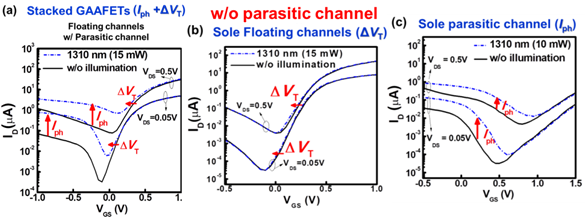 |
|
Fig. 2. ID-VGS of the stacked GeSi floating channels with Ge parasitic channel (a), the sole GeSi floating channels (b), and the sole Ge parasitic channel (c) with no exposure (solid line in black) and 1310-nm illumination (dotted line in blue). |
|
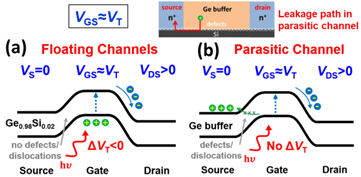 |
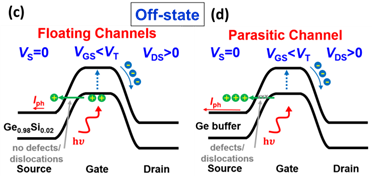 |
|
Fig. 3. The band diagrams at VGS ≈ VT and at off-state of (a, c) the GeSi floating channels and (b, d) the Ge parasitic channel under the infrared illumination if the photocarriers are excited. |
Reference:
[1] S-Y Lin, H-H Liu, C-T Tu, Y-S Huang, F-L Lu, and C. W. Liu, IEEE Trans. on Electron Devices, Vol. 67, No. 10, pp. 4073-4078, Oct. 2020.
[2] H-H Liu, Y-S Huang, F-L Lu, H-Y Ye, and C. W. Liu, IEEE Electron Device Lett., vol. 41, no. 1, pp. 147-150, Jan. 2020.
Dual parametric oscillations from nonlinear photonic crystals
Professor Lung-Han Peng
Graduate Institute of Photonics and
Optoelectronics, National Taiwan University
Prof. PENG recently collaborated with Prof. Azzedine BOUDRIOUA of U. Paris 13 to demonstrate dual parametric oscillations from nonlinear photonic crystals without external cavity mirrors. GIPO Ph.D. student Mr. K.-H. Chang, who is under a dual-degree program between NTU and UP 13, participated in this work with S Mohand Ousaid in U. Paris 13. This collaboration was published in J. Opt.
23, 115501 (2021) with a title “Multi-resonant forward optical parametric oscillations without external mirrors based on nonlinear photonic crystals of LiTaO3,” based upon periodically poled LiTaO3 developed at NTU. We confirmed the OPO oscillation under the conditions of with and without external cavity mirrors, revealing the same slope of conversion efficiency of 9.6% for the transmitted signal waves but varied only in the threshold. We ascribed the oscillations due to feedback from optical reflection on the highly polished facets. This can lead two pairs of (signal, idler) waves oscillations to occur at optical thresholds of 100 MW/cm2 and 180 MW/cm2, respectively, for the first and the second OPO from a single-period 8.82μm 1D PPLT. Our analysis indicates that the quasi-phase-matching condition for the second OPO is caused by local index variation which reveals a competing effect between quadratic cascading and electro-optic induced refractive index changes.
3D optical coherence tomography for visualizing the structures of cells cultivated in complex culture systems
Professor Sheng-Lung Huang
Graduate Institute of
Photonics and
Optoelectronics,
National Taiwan
University
Three-dimensional (3D) configuration of in vitro cultivated cells has been recognized as a valuable tool in developing stem cell and cancer cell therapy. However, currently available imaging approaches for live cells have drawbacks, including unsatisfactory resolution, lack of cross-sectional and 3D images, and poor penetration of multi-layered cell products, especially when cells are cultivated on semitransparent carriers. Herein, we report a prototype of a full-field optical coherence tomography (FF-OCT) system with isotropic submicron spatial resolution in en face and cross-sectional views that provides a label-free, non-invasive platform with high-resolution 3D imaging. We validated the imaging power of this prototype by examining (1) cultivated neuron cells (N2A cell line); (2) multilayered, cultivated limbal epithelial sheets (mCLESs); (3) neuron cells (N2A cell line) and mCLESs cultivated on a semitransparent amniotic membrane (stAM); and (4) directly adherent colonies of neuron-like cells (DACNs) covered by limbal epithelial cell sheets. Our FF-OCT exhibited a penetrance of up to 150 μm in a multilayered cell sheet and displayed the morphological differences of neurons and epithelial cells in complex coculture systems. This FF-OCT is expected to facilitate the visualization of cultivated cell products in vitro and has a high potential for cell therapy and translational medicine research.
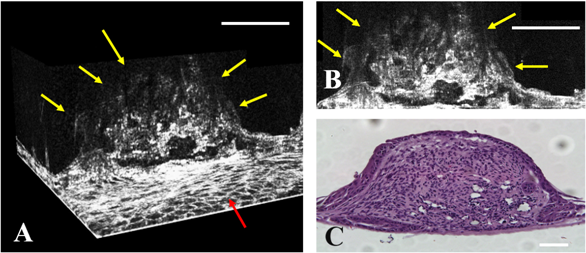 |
|
 |
|
 |
|
Fig. 1. The histological, 3D and 2D cross sectional FF-OCT images of multi-layered cultivated cell sheets. (A) FF-OCT 3D images of DACN. Yellow arrows show the outline surface of the DACN. Red arrow shows the epithelial type of cells spread at the bottom of DACN. (B) FF-OCT 2D images of DACN. Yellow arrows show the outline surface of the DACN. (C, D) Hematoxylin and eosin (H&E) staining of the cross-sectional DACN clearly demonstrated two different cell types, with epithelial like cells covered the colonies of neuron like cells from the bottom to the whole superficial surface. (E) 2D cross sectional FF-OCT images of DACN clearly demonstrated epithelial like cells covering the surface of neuron like cells. (D, E) Green arrow indicates the superficial epithelial cells. Red arrow indicates the neuron like cells. (A, B) Scale bar = 100 μm. (C) scale bar =50 μm. (D, E) scale bar= 25 μm. DACN: directly adherent colonies of neuron like cells. |
Reference:
C. Y. Tsai, C. H. Shih, H. S. Chu, Y. T. Hsieh, S. L. Huang, and W. L. Chen, “Sub-micron spatial resolution optical coherence tomography for visualizing the 3D structures of cells cultivated in complex culture systems,” Scientific Reports, 11, 3492, 2021.
Imaging melanin quantitatively with a high 3D spatial resolution in human skin
Professor
Chi-Kuang Sun
Graduate Institute of
Photonics and
Optoelectronics, National
Taiwan University
The capability to image the 3D distribution of melanin in human skin in vivo with absolute quantities and microscopic details will not only enable noninvasive histopathological diagnosis of melanin-related cutaneous disorders, but also make long-term treatment assessment possible. Recently, we developed the label-free third-harmonic-generation (THG) enhancement-ratio microscopy and demonstrated clinical in vivo imaging of the melanin distribution in human skin with absolute quantities on mass density and with microscopic details [1]. As the dominant absorber in skin, melanin provides the strongest THG nonlinearity in human skin due to resonance enhancement. We show that the THG-enhancement-ratio (erTHG) parameter can be calibrated in vivo and can indicate the melanin mass density (Fig 1). With an unprecedented clinical imaging resolution, we further applied the erTHG-microscopy’s unique capability for long-term treatment assessment in solar lentigines and melasma, and direct clinical observation of melanin’s micro-distribution, cellular morphological changes and other in vivo histological morphologic parameters. We observed the melanocytes remain hyperactivation after treatment in melasma patients after treatments (Fig 2), and the height of basal keratinocytes remain abnormal in SLs patients after laser treatment (Fig 3). Our study indicates that these parameters can serve as clinical indices to evaluate the histopathological characteristics of pigmentary disorder patients and the effectiveness of treatments. All the clinical research outcomes have been published in
IEEE journal of selected topics in quantum electronics and Biomedical Optical Express [1-3].
|
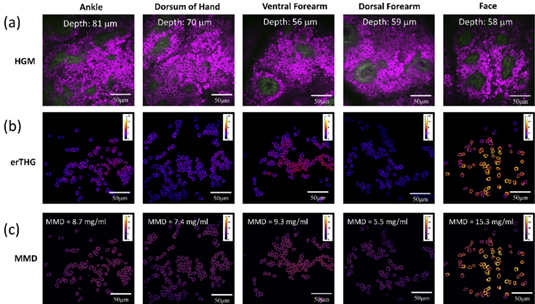 |
|
Fig. 1. Examples of melanin mass density (MMD) and erTHG images. (a). The slide-free in vivo HGM images en-face optically sectioned underneath the skins of dorsal forearm, ventral forearm, ankle, dorsum of hand, and face of different volunteers. (b). The corresponding erTHG images of the segmented cell cytoplasm. (c). The corresponding MMD distribution images inside the cytoplasm of basal cells. Epi-SHG and epi-THG are represented by green and magenta pseudo-colors. erTHG, MMD distribution images are color coded. |
|
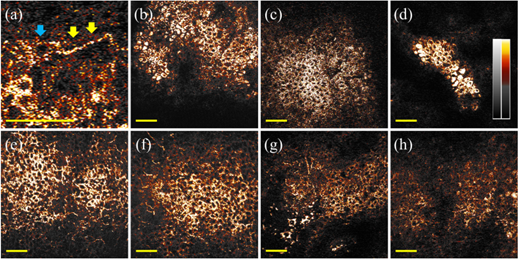 |
|
Fig.2 Representative in vivo THG human skin images with different melanocyte dendricity scores (MDS) in melsam patients. (a) A typical melanocyte in the THG human skin image with a cell body (blue arrow) and an obvious long dendrite (yellow arrow). (b)(c)(d) Examples of THG human skin images with the lowest MDS equivalent to 0. (e)(f)(g)(h) Examples of THG human skin images with the highest MDS equivalent to 3. Scale bar = 50 µm |
|
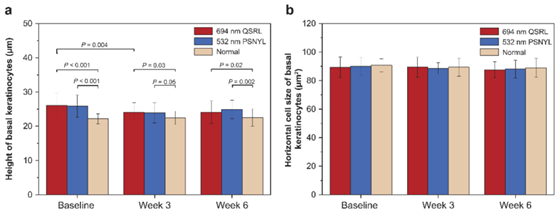 |
| Fig.3 Morphological parameters relevant to basal keratinocytes in SLs patients. The (a) HBK and (b) HCS of basal keratinocytes were analyzed from the en face in vivo HGM images at baseline, week 3, and week 6. Statistical differences were tested using the paired t-test. PSNYL: picosecond Nd:YAG laser; QSRL: Q-switched ruby laser; HBK: height of basal keratinocytes; HCS: horizontal cell size; HGM: harmonic generation microscopy. |
Reference:
[1] Sun, C. K., Wu, P. J., Chen, S. T., Su, Y. H., Wei, M. L., Wang, C. Y., ... & Liao, Y. H. (2020). Slide-free clinical imaging of melanin with absolute quantities using label-free third-harmonic-generation enhancement-ratio microscopy. Biomedical Optics Express, 11(6), 3009-3024.
[2] Wei, M. L., Liao, Y. H., Weng, W. H., Shih, Y. T., Sheen, Y. S., & Sun, C. K. (2021). A Study on Applying Slide-Free Label-Free Harmonic Generation Microscopy For Noninvasive Assessment of Melasma Treatments With Histopathological Parameters. IEEE Journal of Selected Topics in Quantum Electronics, 27(4), 1-10.
[3] Wu, P. J., Chen, S. T., Liao, Y. H., & Sun, C. K. (2021). In vivo harmonic generation microscopy for monitoring the height of basal keratinocytes in solar lentigines after laser depigmentation treatment. Biomedical Optics Express, 12(10), 6129-6142.
Dual-depth Augmented Reality Head-up Display with Holographic Imaging
Professor Hoang-Yan Lin
Graduate Institute of Photonics and
Optoelectronics, National Taiwan University
Head up displays (HUDs) show useful information on a combiner or windshield of a vehicle so that drivers do not need to look down on their dashboards and can focus on the road. As HUDs are proved to increase drivers’ safety and driving experience, HUDs have become more popular over the past decade. Conventionally, head up displays use liquid crystal displays (LCDs) as their picture generation units (PGUs). Most commercial HUDs are LCD-based and project a single image on its combiner. However, as the concept of augmented reality and virtual reality have become well-known and popular, with the upgraded computational speed and performance, augmented reality head up displays (ARHUDs) have become the future of HUDs.
Compared to traditional HUDs, ARHUDs can be designed to provide at least two virtual images with different depths, with at least one virtual image interacting with real world, so that drivers can have immediate reaction without visual conflicts. A straightforward method to realize this concept is to use two or more LCDs as PGUs and corresponding imaging optics to produce several virtual images at different depths. However, this method requires much more cost and volume, which makes it unsuitable for the scenario of HUDs.
As shown in Fig. 1, we develop a dual-focal-plane ARHUD based on holographic imaging, which allows dynamic depths of reconstructed images by varying the modulation of a spatial light modulator (SLM), e.g. liquid crystal on silicon (LCOS). With holographic imaging system in replace of LCDs as PGUs, A single freeform mirror is designed to further magnify the projection sizes and depths, which fits the simultaneous projection of two separated images, reconstructed at two different depths by holographic projection system, producing a far image (15° x 3° at 7 m) and a near image (6° x 2° at 2.5 m), as shown in Fig. 2, in an eyebox of 100 mm by 60 mm. An algorithm on distortion correction based on Code V analysis also shows effective result of correcting the complex and non-radial distortion of freeform off-axis optical system.
|
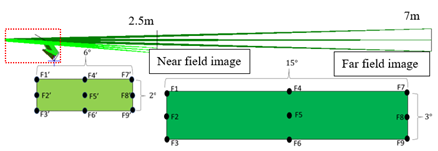 |
|
(a) Illustration of the specifications. |
|
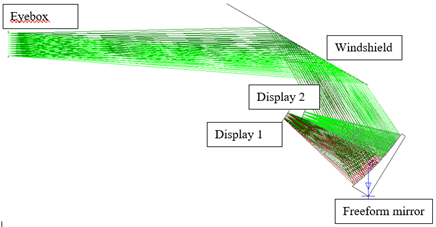 |
|
(b) Layout or magnification of highlighted portion in (a). |
|
Fig. 1. Specification and layout of the HUD. |
|
 |
|
(a) (b) |
|
Fig. 2. Holographic reconstruction of two images with two different depths (a) focused at the near icon, 80 km; (b) focused at the far icon, arrow. |
Reference:
I-Chen Cho, You-Ming Hu, Chih-Hao Chuang, Chi-Wen Lin, Kuan-Hsu Fan-Chiang, and Hoang-Yan Lin, Dual-depth Augmented Reality Head-up Display with Holographic Imaging, 3DSA 2021.
|
|
|
 |
|
 |
|
| |
|
|
 |
|
 |
|
|
|